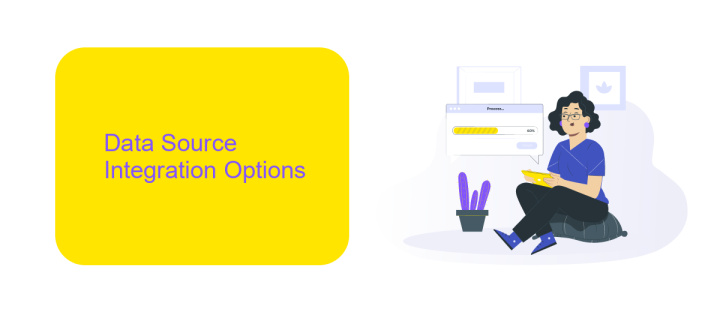CNET Data Source Integration Guide
Integrating data sources effectively is crucial for any organization aiming to leverage data for strategic advantage. This CNET Data Source Integration Guide provides comprehensive steps and best practices to seamlessly combine various data sources, ensuring data consistency, accuracy, and accessibility. Whether you're a data engineer or a business analyst, this guide will help you optimize your data integration processes for enhanced decision-making.
Introduction
Integrating data sources with CNET can significantly enhance the efficiency and accuracy of your data management processes. This guide aims to provide a comprehensive overview of the steps and best practices for seamless integration. Whether you are dealing with large datasets or real-time data streams, understanding the intricacies of CNET's integration capabilities is crucial for optimizing your workflows.
- Understanding CNET's architecture and data handling mechanisms
- Setting up your environment for integration
- Configuring data sources and connection parameters
- Implementing data transformation and validation rules
- Monitoring and troubleshooting integration processes
By following the guidelines outlined in this document, you will be able to leverage CNET's robust features to streamline your data integration tasks. This will not only save time but also ensure that your data is accurate, consistent, and readily available for analysis and decision-making. Dive in to explore how CNET can transform your data management strategy.
Data Source Integration Options

Integrating data sources into your CNET environment can be accomplished through various methods. One of the most straightforward options is using APIs to connect your data sources directly. APIs allow for real-time data exchange and seamless integration with minimal manual intervention. For those who require a more automated solution, services like ApiX-Drive offer a robust platform to connect and synchronize data between multiple systems effortlessly. ApiX-Drive supports a wide range of applications and data sources, ensuring that your integration needs are met with ease and efficiency.
Another viable option is utilizing ETL (Extract, Transform, Load) tools to manage your data integration process. ETL tools help in extracting data from different sources, transforming it into a suitable format, and loading it into your CNET system. This method is particularly beneficial for handling large volumes of data and complex transformations. Combining the strengths of APIs and ETL tools, along with services like ApiX-Drive, provides a comprehensive solution for all your data integration requirements, ensuring your CNET environment remains accurate and up-to-date.
Security Considerations

When integrating CNET data sources, it is crucial to prioritize security to protect sensitive information and ensure compliance with industry standards. Implementing robust security measures helps mitigate risks associated with unauthorized access, data breaches, and other potential threats.
- Authentication and Authorization: Ensure that only authorized users have access to the data sources by implementing strong authentication mechanisms and role-based access controls.
- Data Encryption: Use encryption protocols for data in transit and at rest to safeguard against eavesdropping and unauthorized data access.
- Regular Audits: Conduct regular security audits and vulnerability assessments to identify and address potential security gaps.
- Compliance: Adhere to relevant regulatory requirements and industry standards, such as GDPR, HIPAA, and PCI DSS, to ensure data protection and privacy.
- Incident Response: Develop and maintain an incident response plan to quickly address any security breaches or incidents.
By following these security considerations, organizations can better protect their data assets and maintain the integrity and confidentiality of their CNET data source integrations. Continuous monitoring and updating of security practices are essential to adapt to evolving threats and ensure ongoing protection.
Performance Tuning

Optimizing performance is crucial for ensuring that your CNET data source integration runs smoothly and efficiently. To achieve this, it's important to focus on several key areas such as query optimization, resource allocation, and system monitoring. By taking a proactive approach, you can minimize latency and maximize throughput.
One of the first steps in performance tuning is to analyze and optimize your queries. Inefficient queries can significantly slow down data retrieval and processing. Make sure to use indexes effectively, avoid unnecessary joins, and limit the amount of data being fetched. Additionally, consider caching frequently accessed data to reduce the load on your database.
- Optimize queries by using indexes and limiting data fetches.
- Allocate sufficient resources like CPU and memory.
- Implement caching mechanisms for frequently accessed data.
- Regularly monitor system performance and adjust configurations as needed.
Monitoring your system's performance is an ongoing task. Utilize performance monitoring tools to track key metrics such as CPU usage, memory consumption, and query response times. Regularly review these metrics to identify bottlenecks and make necessary adjustments. By continuously fine-tuning your setup, you can ensure optimal performance and reliability for your CNET data source integration.


Troubleshooting
When encountering issues with the CNET Data Source Integration, first ensure that all API keys and credentials are correctly configured. Double-check that the endpoint URLs are accurate and that the data formats are consistent with the expected schema. If the problem persists, verify that your network settings and firewall rules allow communication with the CNET servers. Using a service like ApiX-Drive can simplify the integration process by providing a user-friendly interface to manage and test your API connections.
If you are still facing difficulties, consult the API documentation for any recent updates or changes that might affect your integration. Additionally, review the logs for any error messages or warnings that could provide clues to the root cause. For more complex issues, consider reaching out to CNET's support team or exploring community forums for advice from other users who may have encountered similar problems. Remember, regular updates and maintenance of your integration setup can prevent many common issues.
FAQ
What is CNET Data Source Integration?
How can I set up CNET Data Source Integration?
What types of data can be integrated from CNET?
Is coding required for setting up CNET Data Source Integration?
How do I ensure data security during integration?
Routine tasks take a lot of time from employees? Do they burn out, do not have enough working day for the main duties and important things? Do you understand that the only way out of this situation in modern realities is automation? Try Apix-Drive for free and make sure that the online connector in 5 minutes of setting up integration will remove a significant part of the routine from your life and free up time for you and your employees.

